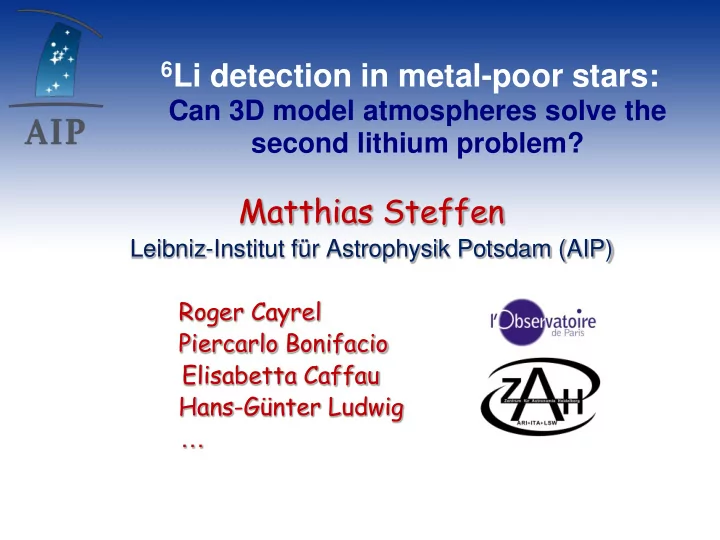

6 Li detection in metal-poor stars: Can 3D model atmospheres solve the second lithium problem? Matthias Steffen Leibniz-Institut für Astrophysik Potsdam (AIP) Roger Cayrel (Paris) Piercarlo Bonifacio (Paris) Elisabetta Caffau (Heidelberg) Hans-Günter Ludwig (Heidelberg) …
Can 3D model atmospheres solve the second lithium problem? M. Steffen, R. Cayrel, P. Bonifacio, E. Caffau, H.-G. Ludwig, et al. Introduction: Line asymmetry due to stellar granulation and 6 Li Method of analysis: 3D NLTE line formation calculations for lithium Results: 1D 3D correction of the Asplund et al. (2006) 6 Li abundances 3D NLTE analysis of real stars: G020-024, G271-162, HD 160617, HD 74000, G275-4, HD 84937 Conclusions
The second lithium problem 7Li Problem 1 Spite plateau log (Li) Problem 2 6Li 6Li plateau BBN: log (6Li) -2 [Fe/H] (Asplund et al. 2006)
A radical solution of the 2nd lithium problem A&A 473, L37 (2007) Instead of invoking new physics, we considered the possibility that … Previous 6 Li detections are only upper limits ignoring the intrinsic, convection-induced line asymmetry results in a systematic overestimation of the 6 Li abundance A systematic reappraisal of former determinations of 6 Li abundances in halo stars is needed requires spectra of the highest possible quality
Spectroscopic signature of 6 Li A( 6 Li + 7 Li) = const.
Spectroscopic signature of 6 Li A( 7 Li) = const. 0.5% High-quality spectra needed ( R 100 000, S/N 500)
Determination of the 6 Li / 7 Li isotopic ratio Fitting of observed spectrum with grid of synthetic line profiles Fixed: mic , v sin i, FWHM (instrumental) 4 free fitting parameters: Lithium abundance: A( 6 Li + 7 Li) Isotopic ratio: 6 Li / 7 Li Residual line broadening: mac Global Doppler shift: Δ v
6 Li detection in HD84937 Cayrel et al. (1999) 6 Li/ 7 Li=5.2%
Stellar granulation and convective line asymmetry Strong blue-shifted + weak red-shifted profile asymmetry After Dravins et al. (1981)
CO 5 BOLD 3D hydrodynamical simulations of surface convection in metal-poor stars log Ross -8 log Ross 0 log Ross +7.5 typically 140 x 140 x 150 cells realistic MARCS opacities Teff = 6300 K, log g = 4.0, [M/H] = 2 RT in 6 or 12 opacity bins
Spectroscopic signature of convection in the atmospheres of metal-poor stars Fe I 6677 Å 1D LTE Teff = 6300 K 3D LTE log g = 4.0 = 2 [M/H]
Fitting procedure: 1D versus 3D 1D fitting: symmetric 7 Li profile 7 Li 6 Li 3D fitting: asymmetric 7 Li profile 6 Li 7 Li 3D analysis expected to yield higher 6 Li / 7 Li isotopic ratio
3D-NLTE line formation in metal-poor stars Lithium model atom Lithium atom 17 levels 1. Radiation field J (x,y,z), : UV .. IR 34 transitions 2. Photo-ionization rates for all levels i 3. Statistical equilibrium equations departure coefficients bi (x,y,z) H + Li H - + Li + : Barklem et al. 2003 Cayrel, Steffen, et al. (2009 )
Li 6707: 3D line formation in LTE / NLTE 3D-NLTE 3D-LTE Li line strength smaller by factor 2 in NLTE
Li 6707: 3D line formation in LTE / NLTE 3D LTE: FWHM = 7.7 km/s 3D NLTE: FWHM = 8.5 km/s
Li 6707: 3D line formation in LTE / NLTE 300 m/s LTE NLTE 200 m/s Li line asymmetry larger in LTE
The CO5BOLD 3D model atmosphere grid status 2011/10 Ludwig et al. (2009 )
3D NLTE corrections of 6 Li / 7 Li derived with 1D LTE Purely theoretical method based on synthetic line profiles: Fitting the same Li 6707 profile with 1D LTE and 3D NLTE 4 free fitting parameters: Lithium abundance: A( 6 Li + 7 Li) Isotopic ratio: 6 Li / 7 Li Residual line broadening: mac Global Doppler shift: Δ v Fixed: mic , v sin i, FWHM (instrumental) Result: Δ ( 6 Li / 7 Li) = correction for intrinsic line asymmetry ( T eff , log g , [Fe/H])
6 Li correction for intrinsic line asymmetry Δ ( 6 Li / 7 Li) for [Fe/H]= -2 4% 3% 2% 1%
6 Li detection by Asplund et al. (2006) Asplund et al. 2006 original values
6 Li detection by Asplund et al. (2006) corrected corrected G020-024 HD102200 CD-30 18140 HD106038
6 Li / 7 Li distribution before and after correction original corrected
Preliminary 6 Li / 7 Li results for six real stars Star Teff log g [Fe/H] 1D LTE 1D LTE 3D NLTE Spectr [K] (A2006) *) *) *) G020-024 7.0 11.7 9.5 ? 6247 3.98 -1.89 UVES HD 160617 5990 3.79 3.6 0 .. 8 -1 .. 7 ? HARPS -1.76 G271-162 1.9 2.1 0.4 UVES 6230 3.93 -2.30 HD 74000 0.6 -1.1 HARPS 6203 4.03 -2.05 --- HD 84937 6.5 4.8 GECKO 6310 4.10 -2.40 --- G275-4 4.5 3.5 6338 4.32 -3.21 --- UVES 6 Li / 7 Li insensitive to assumed v sin i
Using additional “calibration lines” Fixed: mic , v sin i, FWHM (instrumental) Fixed: mac , (macroturbulence) from calibration lines Fitting of observed Li 6707 with grid of synthetic line profiles 3 free fitting parameters: Lithium abundance: A( 6 Li + 7 Li) Isotopic ratio: 6 Li / 7 Li Global Doppler shift: Δ v
1D LTE fitting of HD 74000 calibration lines Anti-correlation between line broadening and 6 Li abundance 6 Li/ 7 Li CaI 6717 + 9 FeI lines +1% +2% +4%
Conclusions Taking intrinsic line asymmetry into account in 3D NLTE reduces the 6 Li / 7 Li ratio by 2% Correcting the Asplund et al. (2006) sample reduces the number of 2 detections from 9 to 2 (G020-024, HD 102200) Remaining detections under 3D NLTE 6 Li / 7 Li 4.8% (2 detection) HD 84937: 6 Li / 7 Li 3.5% (?) G275-4: Fixing the broadening of Li from other lines is problematic (choice of lines) overestimation of 6 Li / 7 Li Further investigations necessary Spectra of even higher quality
Recommend
More recommend